1 comment/ 3220
While exploring the enigmas of Earth’s past, we nearly overlooked discussing the arrangement of celestial bodies in our vicinity – the solar system. However, we shall now address this oversight. I believe that a mere description is fitting for this site, and we shall proceed to delve into the origins, colonization, exploration, etc. on subsequent pages of our website.
Therefore, the solar system
This represents our local area within the immense expanse of the Milky Way galaxy. At the core lies the yellow dwarf star, Sun, encircled by a series of planets. According to traditional theories, there are a total of nine planets. These are familiar to students of all ages. Beginning with the closest to the radiant star, we have Mercury, followed by Venus, Earth, Mars, Jupiter, Saturn, Uranus, Neptune, and finally the farthest dwarf planet, Pluto.
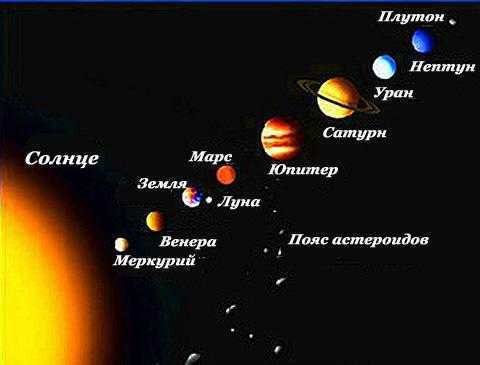
Compared to Earth, the Solar System is not only large, but also incredibly vast. To avoid overwhelming ourselves with mind-boggling numbers in kilometers, scientists have devised a unit of measurement for the immense cosmic expanse known as the astronomical unit. One astronomical unit (AU) is equivalent to 149.6 million kilometers – the average distance between Earth and the Sun.
The distance between the Sun and the planet Pluto provides a rough estimate of the overall size of the solar system. At its closest point to the Sun, known as perihelion, Pluto is about thirty-nine astronomical units away. However, when Pluto reaches aphelion, the farthest point in its orbit, the distance increases to approximately forty-nine astronomical units.
It is a simple task to calculate that the Earth receives light from the Sun in approximately eight minutes, considering that light travels at a speed of 299,792 km/s. This is roughly equivalent to the time an office worker spends engaging in a pleasant conversation with colleagues over a cup of coffee. Imagine holding a coffee pot in your hands, with a gamma-quantum particle originating from the Sun, flying towards our planet. As you place an empty cup on the table and brush away crumbs from a enjoyed treat, this messenger from the yellow star collides with the surface and merges with various other reflected particles. The combined brightness of these reflected sunbeams is referred to as albedo.
To provide some perspective, it takes approximately six hours for light to reach Pluto. However, when considering intergalactic distances, the measurement criteria are vastly different. For instance, when measuring the vast distances to our esteemed neighbor Andromeda, we rely on light years and parsecs as the primary units of measurement.
Additional observations will delight the traveler’s vision and provide solace to their soul: all nine celestial bodies revolve within their designated space in elliptical orbits, ensuring that collisions are impossible. However, our newly appointed astronomer may find it challenging to discern the key detail: the planets are divided into two distinct groups, with an asteroid belt separating them.
Arrangements of planets in the solar system
The initial cluster comprises of four planets that are in proximity to the Sun. These planets include Mercury, Venus, Earth, and Mars. They share numerous similarities, such as having a similar average density of approximately 4.5 g/cm³, being relatively small in size, having a slow rotational movement on their axis, and possessing a limited number of natural satellites. Earth is the only planet that has moons, namely the Moon, while Mars has its own moons called Phobos and Deimos. These four planets are collectively known as the terrestrial group planets.

The gas giants in our solar system consist of Jupiter, Saturn, Uranus, and Neptune.
However, once we move beyond the asteroid belt, the composition of the planets changes significantly. In this region, we encounter four additional planets: Jupiter, Saturn, Uranus, and Neptune. These planets share similarities in terms of their density (averaging at 1.2 g/cm³), massive sizes, rapid rotation, and the presence of numerous satellites. Unlike the inner rocky planets, the gas giants lack solid surfaces and are characterized by atmospheres that are rich in hydrogen and helium. As a result, these four planets are commonly referred to as gas giants.
Standing out from the crowd, we have the small and neat planet Pluto, which shares similar characteristics with the initial group of planets. Nevertheless, its classification has recently changed. It is now labeled as a dwarf planet, according to the International Astronomical Union’s decision. It’s worth mentioning that this ruling did not receive unanimous support from scientists, as many still uphold the belief that Pluto is the ninth planet in our solar system.
Pluto, together with its three moons Charon, Hydra, and Nycta, is situated in the Kuiper Belt, known as the Kuiper Belt, which commences beyond Neptune’s orbit. It’s a vast region, twenty times the size of the asteroid belt. In this vast expanse of the cosmic void, there are numerous enigmatic and unfamiliar entities. It is estimated that there are at least forty thousand of them. Recently, within this distant realm from Earth, several celestial bodies have been classified as dwarf planets. These dwarf planets include Erida, Ceres, Haumea, and Makemake.
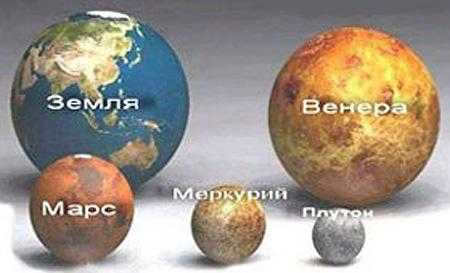
Pluto and the other inner planets
Asteroids and other small dangers.
In addition to the inner planets and the Sun itself, there are smaller celestial formations within the solar system. These include the aforementioned asteroids, comets, and meteorites. The largest of these are the asteroids, some of which can reach thousands of kilometers in diameter. They are also known as minor planets, as they orbit the Sun between the orbits of Mars and Jupiter.
Asteroids can be classified into three categories: carbonaceous, siliceous, and metallic. The main distinction between them, visible to the human eye, is their color. As their name suggests, carbonaceous asteroids contain a significant amount of carbon and thus have a relatively dark surface. They are the most abundant type of asteroid in the solar system, making up seventy-five percent of all minor planets in the C-type class.
There are other types of asteroids, such as the siliceous ones, which are a combination of iron-nickel ore and silicates. Unlike their unattractive counterparts, these asteroids are highly reflective. They make up a smaller percentage, only seventeen percent, of the total number of asteroids. All the remaining minor planets are classified as metallic asteroids, composed mainly of iron and nickel, known as the M-type.
The first asteroid ever discovered in space was given the name Ceres. It has a spherical shape and measures 975 km in diameter at the equator. Other large asteroids include Vesta, Europa, David, Camilla, and many more. Currently, there are approximately one hundred thousand known asteroids in total.
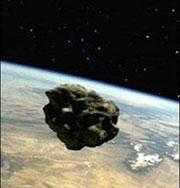
Let’s now discuss meteorites. Terminology is something we need to cover. It may come as an unpleasant surprise to many that anything that can fall from space actually falls onto our beloved blue planet. This includes asteroids lost in space, old comets, and other small solid formations. Therefore, any solid cosmic body that lands on Earth is referred to as a meteorite.
Meteorites continuously rain down on Earth. Experts have estimated that our planet’s atmosphere receives 5-6 tons of space solids every day. That adds up to two thousand tons in a year. Fortunately, not all of them make it to the surface of land and water, as the laws of physics reliably protect us from cosmic chaos.
First and foremost, we must express our gratitude to ablation. Ablation serves as a mechanism to decrease the mass of small celestial objects as they traverse dense layers of the atmosphere.
When a meteor enters Earth’s atmosphere, it travels at a speed of approximately 25 kilometers per second. This rapid velocity of an uninvited visitor from outer space causes it to heat up and emit light. Through the process of ablation, the mass of the extraterrestrial object is significantly reduced. Smaller formations are completely incinerated in the upper atmosphere, leaving no trace, while only minuscule particles make their way to the Earth’s surface. Consequently, out of hundreds of tons of rocky and metallic debris, only grams of these cosmic substances actually reach the blue planet.
However, these are only minor concerns. Nonetheless, a machine weighing several tons has the potential to cause immeasurable disasters to humanity if it were to unexpectedly crash from the sky onto the fertile and familiar expanses of our planet. Fortunately, such incidents occur very infrequently.
Lastly, let’s discuss comets. These celestial bodies are some of the most enigmatic and mysterious objects that voyage through the vast expanse of our Solar System. They originate and reside in the faraway, dark region known as the Oort cloud, which is situated beyond the Kuiper belt. From there, they journey across the orbits of various planets, approach the Sun, complete a circuit around it, retrace their steps, and vanish into the desolate silence of the expansive cosmos.
Every comet becomes visible to Earth-based telescopes after a specific interval of time. Some of these enigmatic objects can reappear within 70 years, while others take 150 years, and there are even those that won’t be seen again for three hundred years.
To bring some order to this matter, comets are classified as either short-period or long-period. Short-period comets have an orbital period of less than 200 years. In contrast, long-period comets have an orbital period exceeding 200 years, as implied by their name. Currently, there are over two hundred known short-period comets and just a little over seven hundred long-period comets.
Actually, only the nucleus of the comet is formed on the distant periphery, not the entire comet. The nucleus is an icy block made up of frozen gas and other volatile substances, with solid particles embedded within. Initially, this frozen mass appears similar to a regular asteroid. However, as the core approaches the Sun, which is about eleven astronomical units away, the transformation begins.
When viewed from Earth, this moving object gradually transforms from a false asteroid into a hazy spot. The coma, a foggy shell, forms around the nucleus. This coma is a result of the vaporization of frozen gas and other volatile substances from the surface of the icy block, which constitutes the solid foundation of the comet.
Over time, the coma starts to stretch out. It possesses a tiny tail that becomes quite noticeable when it reaches a distance of 3-4 astronomical units from the Sun.
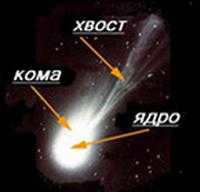
However, in this case, the comet is in very close proximity to the Sun (within a distance of no more than 2 astronomical units). Its tail extends and expands significantly because the radiation from the Sun ejects gas particles from the coma, propelling them backwards. This elongated and smoky tail can reach lengths of hundreds of thousands or even millions of kilometers.
Many comets possess two separate tails: a gas tail and a dust tail. The gas tail emits a luminous plume as it becomes ionized by ultraviolet light and particle streams originating from the Sun’s surface. The dust tail, on the other hand, scatters sunlight and appears as a long, hazy formation.
Comets follow elongated ellipses as they orbit around the celestial body. However, accurately tracing the path of these cosmic objects is not possible. This is because they intersect with the orbits of planets, and the gravitational influence of the planets disrupts their trajectory. Hence, only an approximate orbit of these enigmatic wanderers from the far reaches of the solar system can be calculated.
Comets are intricately linked to mysterious events that took place on Earth millions of years ago. As such, there is a theory suggesting that comets played a vital role in the formation of water and other volatile compounds that are essential for humanity.
Billions of years ago, the dry soil of the once non-blue planet became moist after being bombarded. This bombardment gave rise to the formation of the atmosphere, seas, oceans, rivers, and lakes. Additionally, it brought complex organic compounds to Earth, laying the foundation for the emergence of simple organisms.
The most powerful natural cataclysm 65 million years ago, during the transition from the Cretaceous to the Tertiary periods, is also attributed to comets. It was during this time that dinosaurs and 70% of other Earthly organisms vanished.
According to proponents of this theory, our planet experienced the impact of a comet nucleus (with a diameter of 10 km) containing a significant amount of iridium. This event resulted in a powerful explosion that released a massive quantity of dust into the surrounding atmosphere, effectively blocking out the sun’s rays. As a result, the average temperature plummeted by 10-15 degrees Celsius. The dust remained suspended in the air for an entire year, leading to a sudden and severe cold spell that proved fatal for all living organisms. The presence of an iridium layer in geological sediments corresponds to this ancient period of time.
There exists a wide array of theories and hypotheses that explore not only comets, but also other celestial bodies and formations found within the solar system. Of particular interest is the question surrounding the origin of the Sun and planets.
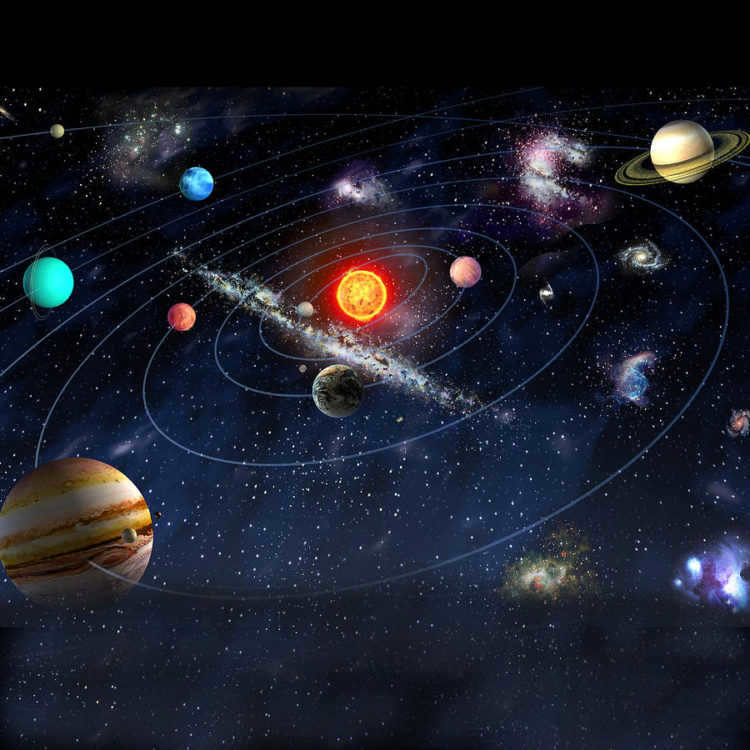
The solar system consists of a collection of planets that orbit around a radiant star known as the Sun. The Sun serves as the primary source of light and warmth within the solar system.
Scientists theorize that our planetary system was formed approximately 4.5 billion years ago through the explosive aftermath of one or more stars. Initially, the solar system existed as a conglomeration of gas and dust particles, but with time and the gravitational pull of its own mass, the Sun and other planets took shape.
The celestial bodies in our solar system
Positioned at the heart of the solar system lies the radiant Sun, encircled by a retinue of eight unique planets: Mercury, Venus, Earth, Mars, Jupiter, Saturn, Uranus, and Neptune.
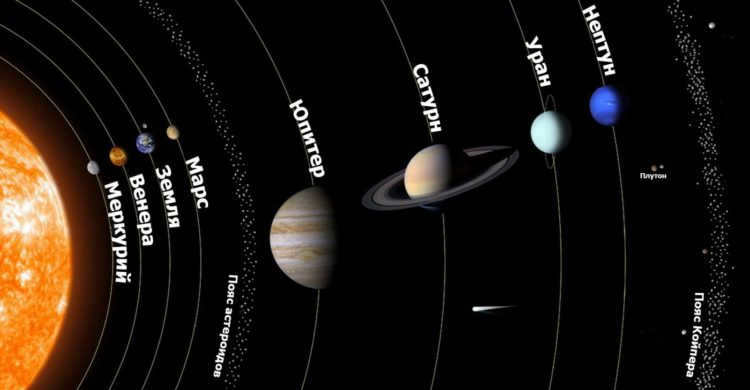
Prior to 2006, Pluto was a member of this planetary group and was recognized as the 9th planet in the Solar System. However, due to its considerable distance from the Sun and relatively small size, it was reclassified as a dwarf planet. In fact, it is one of several dwarf planets situated within the Kuiper belt.
All of the aforementioned planets are typically categorized into two main groups: the terrestrial group and the gas giants.
The terrestrial group encompasses planets such as Mercury, Venus, Earth, and Mars. These planets are characterized by their small size and rocky surfaces, and furthermore, they are situated closer to the Sun compared to the others.
Gas giants such as Jupiter, Saturn, Uranus, and Neptune are known for their immense size and the presence of rings made up of ice dust and rocky debris. These planets consist primarily of gaseous matter.
Mercury
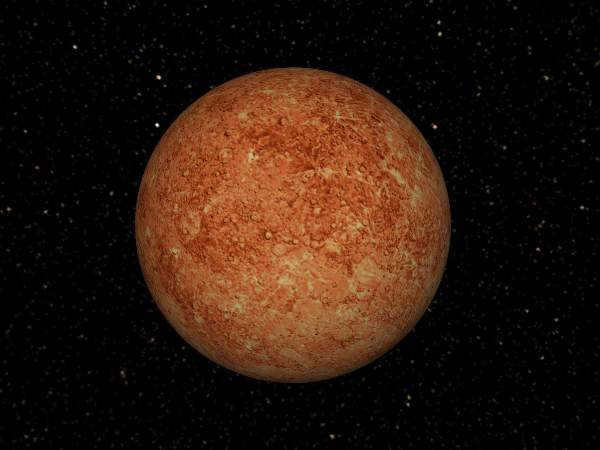
Mercury is one of the smallest planets in our solar system, with a diameter of 4,879 km. It is also the closest planet to the Sun, resulting in a significant temperature difference. During the day, the average temperature on Mercury reaches +350 degrees Celsius, while at night it drops to -170 degrees Celsius.
- Mercury is the first planet in our solar system, located closest to the Sun.
- Unlike other planets, Mercury does not experience seasons due to its almost perpendicular axis tilt in relation to its orbit around the Sun.
- Although Mercury is the closest planet to the Sun, it does not have the highest surface temperature. That distinction goes to Venus.
- Mariner 10 was the inaugural spacecraft to explore Mercury, conducting a series of demonstration flybys in 1974.
- A single day on Mercury spans a lengthy 59 Earth days, while a full year is completed in just 88 days.
- Mercury boasts the most extreme temperature fluctuations, with highs reaching a scorching 610 °C. Daytime temperatures can soar to 430 °C, while nighttime plummets to a bone-chilling -180 °C.
- The gravitational pull on Mercury’s surface is a mere 38% of Earth’s, allowing for three times the jumping height and easier lifting of heavy objects.
- Galileo Galilei made the initial telescopic observations of Mercury in the early 17th century.
- Mercury lacks any natural satellites of its own.
- It was not until 2009 that the first official map of Mercury’s surface was released, thanks to the data collected from the Mariner 10 and Messenger spacecraft.
Venus
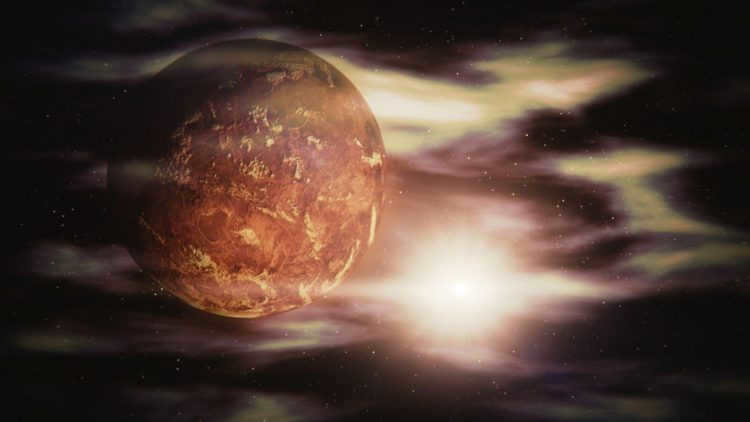
Venus, the second planet from the Sun, is similar in size to Earth, with a diameter of 12,104 km. However, it has several unique characteristics. Unlike Earth, a day on Venus lasts 243 Earth days, while a year lasts 255 days. Its atmosphere is composed mainly of carbon dioxide, making up 95% of the total composition. This results in a greenhouse effect on the planet, leading to an average surface temperature of 475 degrees Celsius. Additionally, the atmosphere contains 5% nitrogen and 0.1% oxygen.
- Venus is the second planet from the Sun in the solar system.
- Despite being the second planet from the Sun, Venus is the hottest planet in the solar system, with surface temperatures reaching up to 475°C.
- The initial spacecraft dispatched to explore Venus was launched from Earth on February 12, 1961, and was designated Venus 1.
- Venus is one of the rare planets in the Solar System with a unique direction of rotation around its axis.
- The planet’s orbit around the Sun is remarkably circular.
- Due to the significant thermal inertia of its atmosphere, the surface temperature of Venus remains relatively consistent throughout day and night.
- Venus completes one orbit around the Sun in 225 Earth days, and one rotation around its axis in 243 Earth days, resulting in a day on Venus lasting longer than a year.
- Galileo Galilei made the earliest recorded observations of Venus through a telescope in the early 17th century.
- Venus lacks any natural satellites.
- Venus is the third most luminous entity in the heavens, following the Sun and the Moon.
Earth
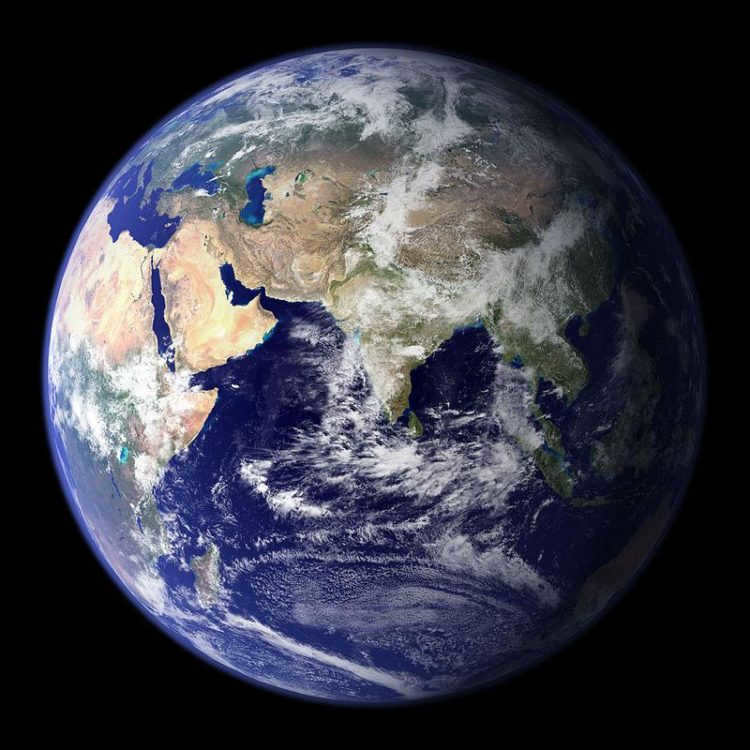
Our planet is situated at a distance of 150 million kilometers from the Sun, allowing it to maintain temperatures suitable for liquid water and therefore enabling the existence of life.
Approximately 70% of its surface is covered in water, making it unique among the planets in our solar system. It is believed that thousands of years ago, atmospheric vapor created the necessary conditions for liquid water to form on Earth’s surface, while solar radiation facilitated photosynthesis and the emergence of life.
- Earth is the third planet in our solar system, located between Mercury and Venus.
- Our planet has one natural satellite, the Moon, which orbits around it.
- Earth, unlike other planets, is not named after a deity;
- Out of all the planets in the solar system, Earth has the highest density;
- The rotational speed of Earth is gradually decreasing;
- The average distance between Earth and the Sun is 1 astronomical unit, which is approximately 150 million kilometers;
- Earth has a magnetic field that is strong enough to shield living organisms on its surface from harmful solar radiation;
- On October 4, 1957, the first man-made satellite called PS-1 (Prostoy Satellite – 1) was launched from the Baikonur Cosmodrome using a Sputnik booster;
- Compared to other planets, Earth has the largest number of spacecraft in orbit around it;
- Earth is the biggest planet in the solar system among the Earth-group planets;
Mars
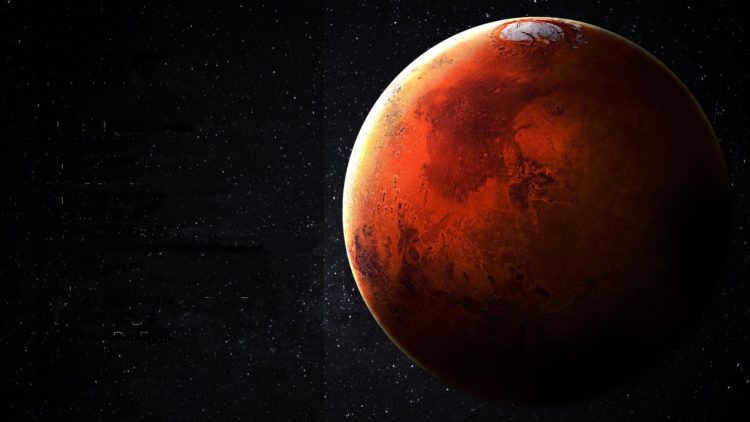
Mars is the fourth planet from the Sun and is situated 1.5 times further away from the Sun than Earth. With a diameter of 6,779 kilometers, Mars is smaller than Earth. The average air temperature on the planet varies from -155 degrees to +20 degrees near the equator. Mars has a much weaker magnetic field compared to Earth, and its atmosphere is quite thin, allowing solar radiation to reach the surface unhindered. Consequently, if there is any life on Mars, it is likely not on the surface.
The Mars rover exploration has revealed that Mars possesses numerous mountains, dried-up riverbeds, and glaciers. The planet’s surface is predominantly covered with red sand, which is attributed to the presence of iron oxide.
- Mars is situated on the fourth orbit from the Sun;
- Out of the 40 expeditions sent to Mars, only 18 have achieved success;
- Mars boasts the largest dust storms in our solar system;
- In approximately 30-50 million years, Mars will possess a ring system similar to Saturn’s;
- Traces of Martian debris have been discovered on Earth;
- The Sun appears half the size from the surface of Mars compared to its appearance from Earth’s surface;
- Mars is the sole planet in our solar system that harbors polar ice;
- Mars is accompanied by two natural satellites, Deimos and Phobos;
- Mars lacks a magnetic field;
Planet Jupiter
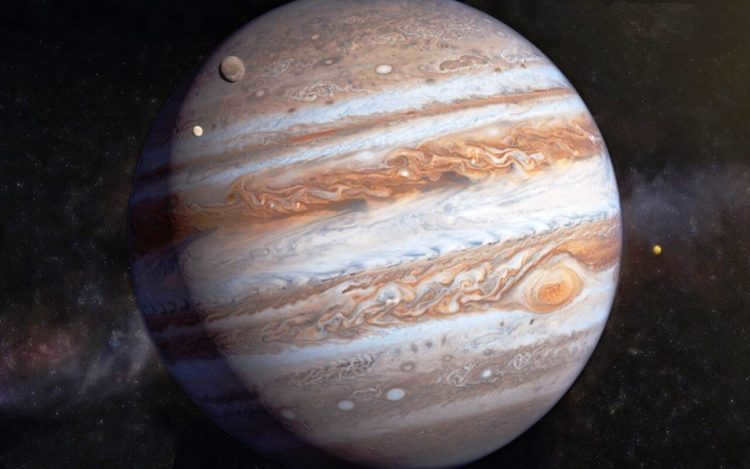
This celestial body is the largest in our solar system and boasts a diameter of 139,822 km, a size that is 19 times greater than that of Earth. A single rotation on Jupiter takes 10 hours, while a full orbit around the Sun takes approximately 12 Earth years. Jupiter’s composition is primarily made up of xenon, argon, and krypton. If it were 60 times larger, it could potentially undergo a spontaneous thermonuclear reaction and become a star.
The average temperature on Jupiter is a bone-chilling -150 degrees Celsius. Its atmosphere is predominantly composed of hydrogen and helium, with no traces of oxygen or water on its surface. There have been suggestions that there may be pockets of ice within Jupiter’s atmosphere.
- Jupiter is situated in the fifth orbit from the Sun;
- In the Earth’s sky, Jupiter is the fourth most luminous object, following the Sun, Moon, and Venus;
- Jupiter boasts the shortest day among all the planets in our solar system;
- Jupiter’s atmosphere is home to one of the most powerful and long-lasting storms in the entire solar system, famously known as the Great Red Spot;
- Ganymede, one of Jupiter’s moons, holds the title for being the largest moon in our solar system;
- Encircling Jupiter is a delicate system of rings;
- Jupiter has been explored by a total of 8 scientific spacecraft;
- Jupiter possesses a robust magnetic field;
- If Jupiter were 80 times more massive, it would have enough mass to ignite and become a star;
- Jupiter is orbited by a staggering 67 natural satellites, making it the planet with the most moons in our solar system;
Saturn
can be described as a planet in the solar system. It is the sixth planet from the Sun and is known for its distinctive set of rings. Saturn is a gas giant, meaning it is primarily made up of hydrogen and helium. It has a diameter of about 116,464 kilometers, making it the second-largest planet in our solar system. Saturn has an average density that is lower than water, which means it would float if placed in a large enough body of water. It has a unique feature called a hexagon-shaped storm at its north pole, which has perplexed scientists for years. Saturn also has numerous moons, with the largest being Titan. Overall, Saturn is a fascinating planet that continues to captivate astronomers and researchers alike.
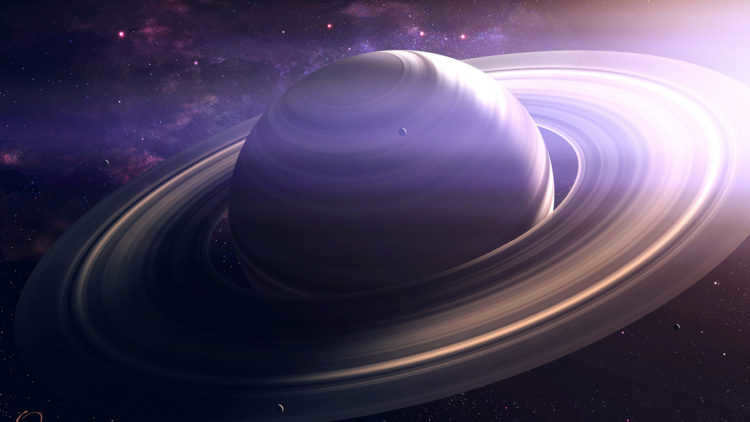
The second largest planet in our solar system is Saturn. It has a diameter of 116,464 kilometers and is similar in composition to the Sun. Saturn has a long year, lasting almost 30 Earth years, and a day on Saturn is only 10.5 hours. The average temperature on Saturn’s surface is a chilly -180 degrees Celsius.
Saturn’s atmosphere is mainly made up of hydrogen with a small amount of helium. Thunderstorms and auroras are often produced in its upper layers.
- Saturn is the sixth planet from the Sun.
- Saturn has the strongest winds in the solar system.
- Saturn is one of the least dense planets in the solar system.
- Saturn is surrounded by the largest ring system in the solar system.
- A single day on Saturn lasts almost as long as a year on Earth, totaling 378 Earth days;
- Four different research spacecraft have explored Saturn;
- Together, Saturn and Jupiter account for approximately 92% of the total mass of all planets in the solar system;
- A year on Saturn is equivalent to 29.5 Earth years;
- There are currently 62 known natural satellites orbiting around Saturn;
- The Cassini Automated Interplanetary Station is currently studying Saturn and its rings;
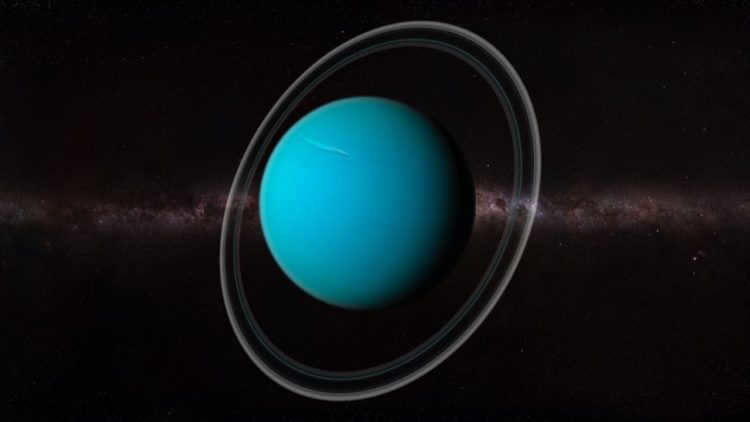
Uranus is known as the seventh planet from the Sun and is the third largest planet in our solar system. It has a diameter measuring 50,724 kilometers and is often referred to as the “ice planet” due to its extremely cold surface temperature of -224 degrees Celsius. The rotation of Uranus is unique in that a day on this planet lasts 17 hours, while a year is equivalent to 84 Earth years. Another fascinating fact about Uranus is that its seasons are incredibly long, with both summer and winter lasting 42 Earth years. This phenomenon is a result of Uranus’ axis being tilted at a 90-degree angle to its orbit, causing it to appear as if it is “lying on its side.”
- Uranus is situated on the seventh orbit around the Sun.
- The discovery of Uranus was credited to William Herschel in 1781.
- Voyager 2, in 1982, is the only spacecraft to have visited Uranus.
- Out of all the planets in the solar system, Uranus holds the title for being the coldest.
- Uranus’ equatorial plane is at an almost right angle to the plane of its orbit – in other words, the planet rotates in a retrograde motion, “tilted on its side and slightly upside down”.
- The moons of Uranus are named after the works of William Shakespeare and Alexander Pope, rather than being named after figures from Greek or Roman mythology.
- A day on Uranus lasts approximately 17 Earth hours.
- There are currently 13 known rings encircling Uranus.
- One year on Uranus is equivalent to 84 Earth years.
- There are 27 confirmed natural satellites orbiting around Uranus.
Neptune
Neptune is the eighth and farthest known planet from the Sun in the Solar System. It is the fourth-largest planet by diameter and the third-largest by mass. Among the gaseous planets in the solar system, Neptune is the most dense. Neptune is 17 times the mass of Earth and is slightly more massive than its near-twin Uranus, which is 15 times the mass of Earth but not as dense.
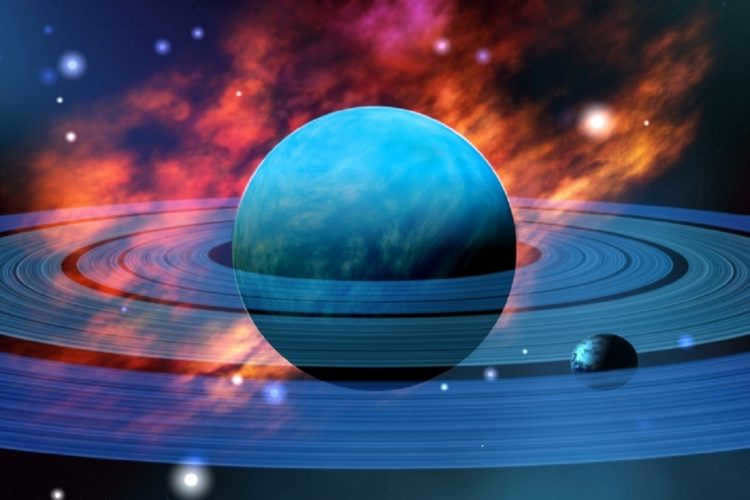
Neptune, the eighth planet in our solar system, shares many similarities with its neighboring planet Uranus. With a diameter of 49,244 kilometers, Neptune is similar in size to Uranus. A day on Neptune lasts for 16 hours, while a year on this planet is equivalent to 164 Earth years. Initially, it was believed that Neptune’s icy surface had no weather phenomena. However, recent discoveries have shown that Neptune experiences the highest wind speeds out of any planet in our solar system, reaching up to 700 kilometers per hour.
Neptune boasts a total of 14 satellites, with Triton being the most well-known. Triton is unique in that it has its own atmosphere.
In addition to its satellites, Neptune also possesses six rings, making it a truly remarkable planet.
- Neptune is the most distant planet from the Sun, occupying the eighth orbit in our solar system;
- Mathematicians were the first to discover the existence of Neptune;
- Neptune is orbited by a total of 14 satellites;
- The average distance between Neptune and the Sun is 30 astronomical units (a.u.);
- A day on Neptune lasts for 16 hours, which is equivalent to one Earth day;
- So far, the only spacecraft to have visited Neptune is Voyager 2;
- Neptune has its own ring system;
- After Jupiter, Neptune has the second highest gravity in the solar system;
- One year on Neptune is equivalent to 164 Earth years;
- The atmosphere on Neptune is known for its extreme activity;
50 fascinating facts about our solar system
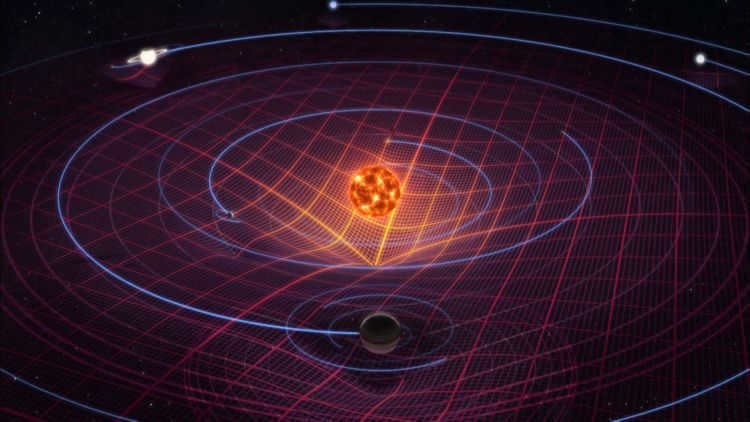
- Jupiter is known as the largest planet within our solar system.
- Within our solar system, we have 5 dwarf planets, and one of them is formally known as Pluto.
- There is a limited number of asteroids present in our solar system.
- Venus holds the record for being the hottest planet in our solar system.
- The Sun takes up around 99% of the space (in terms of volume) within our solar system.
- Saturn’s moon is considered one of the most breathtaking and unique locations in our solar system. This moon showcases massive concentrations of ethane and liquid methane.
- Our solar system possesses a tail that resembles the shape of a four-leaf clover.
- The Sun follows an ongoing 11-year cycle.
- Our solar system consists of a total of 8 planets.
- All spacecraft have reached every planet in the solar system.
- Venus is the only planet in the solar system that rotates counterclockwise.
- There are 27 satellites orbiting Uranus.
- Mars is home to the largest mountain in the solar system.
- A vast number of objects in the solar system originated from the Sun.
- The Milky Way galaxy encompasses the entire solar system.
- At the center of the solar system lies the Sun.
- The solar system is commonly divided into various regions.
- The Sun plays a crucial role in the solar system.
- The formation of the solar system took approximately 4.5 billion years.
- Pluto holds the title for being the most distant planet in the solar system.
- There are two regions in the solar system filled with numerous small bodies.
- The structure of the solar system defies the laws of the universe.
- In terms of size, the solar system is comparable to a grain of sand in the vastness of space.
- Throughout history, the solar system has experienced the loss of two planets: Vulcan and Pluto.
- Scientists claim that the solar system was artificially created.
- Among all the satellites in the solar system, Titan stands out for its dense atmosphere and cloud-covered surface.
- The region of the solar system beyond Neptune’s orbit is known as the Kuiper belt.
- The Oort cloud, which is a source of comets with long orbital periods, is another region in the solar system.
- Gravity is the force that keeps every object within the solar system in place.
- The prevailing theory about the formation of planets and moons in the solar system involves their emergence from a massive cloud.
- The solar system is known as the most mysterious part of the universe.
- Within the solar system, there exists a vast asteroid belt.
- Witness the eruption of Olympus, the largest volcano in the solar system, on Mars.
- Pluto marks the outer limits of the solar system.
- Jupiter harbors a massive ocean of liquid water.
- The moon holds the distinction of being the largest satellite in the solar system.
- Pallada is recognized as the largest asteroid within the solar system.
- Venus shines as the brightest planet in the solar system.
- The solar system is primarily composed of hydrogen.
- Earth holds an equal standing within the solar system.
- The sun gradually warms up over time.
- Interestingly, the sun contains the largest reservoir of water in the solar system.
- The plane of each planet’s equator in the solar system deviates from the plane of its orbit.
- Phobos, a moon of Mars, is a unique feature within the solar system.
- The solar system can be truly astonishing in its diversity and vastness.
- The Sun has a significant impact on the planets in the solar system.
- The outer region of the solar system is home to gas giants and satellites.
- A considerable number of planetary satellites in the solar system are lifeless.
- Ceres, with a diameter of 950 kilometers, is the largest asteroid.
- The Vela pulsar
- Jupiter’s magnetosphere
- The sounds of Earth’s atmosphere
- The pulsation of the Sun
- Ganymede’s magnetosphere
- Black Hole GRS 1915+105
- Saturn’s radio emission
- Lightning sounds
The American research satellite Voyager was the first to record the sounds of space. NASA even released a “space music” CD in the US. However, the sound that humans hear is slightly different. In space, there are no sound waves, but there are electromagnetic waves. These waves are the source of the recordings. Scientists processed and converted these waves into audible sound waves.
- Real-time monitoring of the sun
- Solar wind
- Heliosphere
- Direction of solar flare
- Moon monitoring
- Ionosphere monitoring
- Forecasting magnetic storms
- Meteorological monitoring
- Natural fire monitoring
- Atmospheric monitoring
- Cloud monitoring
- Seismic monitor
- Asteroid and comet monitoring
- Cyberattack monitoring
- Online starry sky map
- Ozone Hole Monitoring
- Interactive map of global military actions
- Marine Vessel Monitor
- Global Warming Map
- Magnetic Field Monitoring in Moscow
- Schumann Resonance Frequencies
- Vulkan Monitor
- X-ray radiation monitoring
- Global map of cataclysms
- Natural disasters and man-made catastrophes
- Radiation situation in your region
- Magnetic Storms – Survival
- 3D model of the Solar System
- Star map
- Planetarium
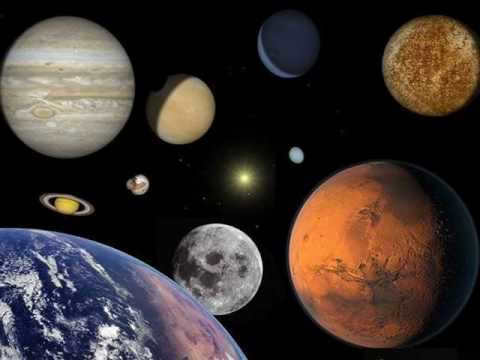
Retaining information
During our time in school, we often struggled with memorizing the multiplication table and expanding our vocabulary. Similarly, we were faced with the challenge of memorizing the arrangement of the planets in the solar system as presented in our natural history textbook, and we diligently sought out effective strategies to achieve this. Fortunately, there are several intriguing and beneficial approaches to tackling this task.
Mnemonics: the Art of Memorization
The ancient Greeks devised a solution for today’s students: mnemonics. The term itself derives from a consonant Greek word that translates to “the art of memorizing”. This art form gave rise to a comprehensive system of techniques known as “mnemotechnics”.
These techniques are incredibly useful when it comes to memorizing extensive lists of names, important addresses or phone numbers, or even the sequential arrangement of objects. When it comes to our solar system’s planets, such a technique proves to be absolutely essential.
Playing with connections or “Ivan had a daughter…”
We all remember and are familiar with this verse from elementary school. It is a mnemonic device. We are referring to the rhymes that help a child memorize the Russian language cases – “Ivan had a daughter – he told her to bring a diaper” (Nominative, Genitive, Dative, Accusative, Instrumental, and Prepositional, respectively).
Can we apply the same technique to the planets of our solar system? – Absolutely. There have already been numerous mnemonics created for this astronomical puzzle. The key is to use associative thinking. Some people find it helpful to visualize an object that resembles the planet they are trying to remember, while others find it sufficient to create a mental chain of names in a coded form. Here are a few suggestions on how to memorize their positions effectively, considering their distance from the sun.
Hilarious images
You can easily remember the order in which the planets in our solar system are arranged by using visual representations. Start by assigning a specific image to each planet, it could be an object or even a person. Then, visualize these images in the exact order of the planets’ positions within the solar system.
- Mercury. If you haven’t seen any pictures of this ancient Greek god, think about the late lead singer of the band “Queen” – Freddie Mercury, whose last name sounds like the name of the planet. It’s unlikely that children would know who this uncle is. So, we propose coming up with simple word combinations, where the first word starts with the syllable MER, and the second word starts with CUR. And they should describe specific objects that will then become a “picture” for Mercury (this technique can be used as the most extreme option with each of the planets).
- Venus. Many people have had the opportunity to view the renowned statue of Venus de Milo. If you share it with your children, they will easily remember this “armless relative.” Additionally, it serves as an educational tool for the younger generation. You can ask them to recall someone they know, like a friend, classmate, or family member, who shares the same name – just in case they encounter someone with that name in their social circle.
- Earth. The concept here is straightforward. Picture yourself as an Earthling, situated between two planets in the vastness of space – one before and one after our own.
- Mars. In this instance, advertising can serve a dual purpose by promoting both commerce and scientific knowledge. Imagine a popular imported chocolate bar in place of the planet, and you’ll grasp the idea.
- Jupiter. Imagine a famous landmark in St. Petersburg, like the Bronze Horseman. Despite starting with the letter Y, the locals refer to the “Northern Capital” as Peter. To make it easier for children, create a word combination with them.
- Saturn. This planet is known for its rings and doesn’t require a visual image. If you’re having trouble, imagine a sports stadium with a treadmill. This association has already been used in an animated movie about space.
- Uranus. The best “picture” for this planet is someone celebrating a great achievement and shouting “Hurray!”. Adding one letter to this exclamation is something every child can do.
- Neptune. Let your children watch the animated film “The Little Mermaid” – let them remember Ariel’s father – the King with a mighty beard, impressive muscles, and a huge trident. And it doesn’t matter that His Majesty’s name is Triton. Neptune also possessed this tool in his arsenal.
- And now – once again, mentally visualize everything (or everyone) that reminds you of the planets of the solar system. Flip through these images like pages in a photo album, from the first “picture”, the closest to the Sun, to the last, whose distance from the star is the greatest.
“Hey, check out these rhymes…”
Now, let’s talk about mnemonics, which use the “initials” of the planets to help us remember their order in the Solar System. It’s actually easiest to memorize the planets by their first letters. This technique is perfect for those who don’t have a strong imaginative thinking, but are good with associations.
Here are some examples of rhymes that can help you remember the order of the planets:
“The Brave Grizzly went Out for Raspberries – The Loyal Lion Managed to Get Away Looking Out for Wonders.”
“We all know: Yellow Umbrellas make mornings magical.”
There is an option to not fold the poem and instead select words that start with the first letters of each planet’s name. Here’s a handy tip: to avoid confusion between Mercury and Mars, both starting with the letter M, use the first syllables – ME and MA respectively – at the beginning of your words.
For instance: The magnificent cats were visible in the MEs, they were shouting as if they had spotted us.
The possibilities for such sentences are endless – as long as you have enough creativity. In summary, give it a try, practice, and commit to memory…
An astronomer named Claudius Ptolemy hailing from the city of Alexandria was the first to establish a comprehensive mathematical theory regarding the movements of the celestial bodies in the sky, drawing upon the knowledge of his predecessors. Ptolemy’s groundbreaking ideas centered around placing the Earth at the core of the universe, thus giving birth to what is known as the geocentric model of the cosmos. This marked a significant milestone in the exploration of the entire solar system. Ptolemy’s theories enjoyed widespread acceptance for over a millennium and a half.
In the 16th century, Nicolaus Copernicus formulated the heliocentric model of the universe, which posited that the Sun, rather than the Earth, is positioned at the center of the solar system. This revolutionary idea challenged the prevailing belief that the Earth was stationary, highlighting the fallibility of human senses. In reality, the Earth is in constant motion, orbiting the Sun at a considerable velocity.
It should not be assumed that Ptolemy, who formerly positioned the Earth at the center of the universe, was an unscrupulous and misguided fool, and Copernicus enlightened people to the actual scientific reality. Ptolemy, for his era, accomplished a significant scientific feat: he devised a comprehensive theory that mathematically accurately described the movements of all observable celestial bodies. His theory was derived from observation and confirmed through observation. It became a benchmark for all subsequent natural science. Ptolemy, as the architect of this theory, can rightfully be regarded as one of the pioneers of natural science. However, in the figure of Copernicus, science had to challenge the grand theory for the first time. It turns out that scientific truths are not everlasting fortresses: they require periodic reassessment. Science occasionally rejects what once appeared absolutely unassailable. And therein lies one of the crucial lessons of scientific progress!
The birth of the discipline of science, astrophysics, took place in the mid-19th century. Over the course of a century and a half, astrophysics has led to numerous significant discoveries in the study of planets. However, it was only with the advent of the space age that a true revolution in our understanding of the solar system’s bodies occurred. Today, our knowledge about the cosmic neighborhood of Earth is exponentially greater than it was just a decade or two ago. The maps featured in this section are based on the “Atlas of the Earth Group Planets and Their Satellites” created by MIIGAiK, which utilized maps of Mercury, Venus, the Moon, and Mars.
Planets in the Solar System
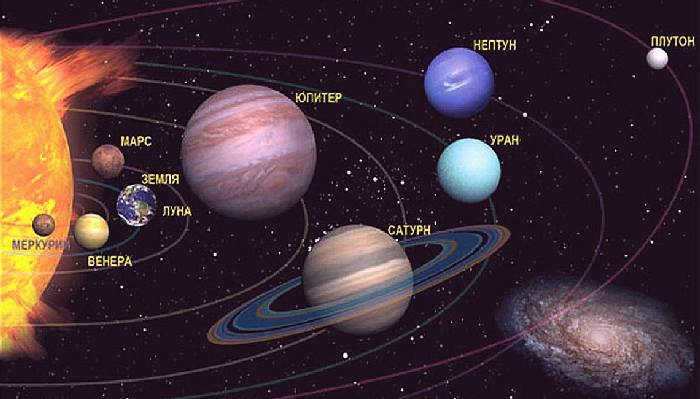
Celestial objects that are too cold to emit their own light, such as stars, are typically spherical in shape and much smaller in mass and size compared to stars. These objects have long been referred to as planets. Many stars have systems of multiple planets that are held in place by the force of gravity. The planets orbiting the Sun, especially our own planet – Earth, are the most well-studied. These planets, along with the Sun, make up the solar system.
The planets in our Solar System are visible to us on Earth because they reflect sunlight. When we look up at the night sky, we see these planets as shining stars, each with its own unique light. Currently, we know of 9 planets in our solar system, including our own planet Earth. These planets are named after Greek and Roman gods and goddesses. Throughout history, ancient civilizations were able to observe five of these planets with the naked eye, while the discovery of the other three required the use of telescopes. The most recent planet to be discovered was Pluto in 1930. Although astronomers have not yet found any additional planets in our solar system, they continue to search and remain hopeful for future discoveries.
Planets’ characteristics
(in the order they are located from the Sun)
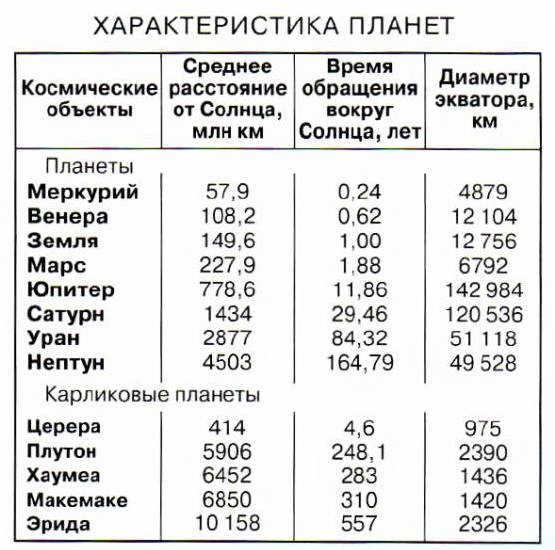
The average distance between the Earth and the Sun is 149,600,000 kilometers.
The Earth completes one revolution around the Sun in 365.256 days.
The mass of the Earth is 5.976 x 10^27 grams.
The average density of the Earth is 5.52 grams per cubic centimeter.
Formation and Origin of the Solar System
The planets in our solar system are arranged in a disk-like shape near the plane that passes through the Sun’s equator. They all orbit the Sun in the same direction, from west to east. According to current theories, the Sun and the planets formed together from a cloud of gas and dust. This massive cloud was cold and had an irregular shape.
As a result of gravitational forces, the cloud gradually started to twist and flatten. Within its central region, a mass of material condensed, which would eventually become the Sun. The central mass continued to grow, eventually forming a spherical shape and igniting thermonuclear reactions that produced immense amounts of light and heat. The volatile substances in proximity to the Sun were vaporized and ejected towards the densest and thickest part of the cloud. The particles within the cloud, revolving around the blazing star-Sun, collided and merged together, giving rise to the early forms of planets. The planets closer to the Sun were smaller and less substantial, while the ones in the central part of the cloud expanded and became more massive. This entire process took place approximately 5 billion years ago.
The rocky planets
Scientists have conducted extensive drilling operations across the surface of our planet Earth. The most impressive wells ever drilled on land have been located within our own country and have reached depths of up to 12 kilometers. While this may seem like a significant depth, it pales in comparison to the vast size of our planet, which boasts a cross-section of about 13 thousand kilometers. To put this into perspective, if we were to compare the Earth to the human body, even the deepest boreholes would be shallower than a mosquito bite. As a result, researchers have had to employ a variety of alternative methods to gather information about the Earth’s internal structure, as drilling alone is not sufficient.
Sensitive seismometers record vibrations from sources deep within the Earth’s body during seismic events. These data provide insight into the speed at which vibrations propagate through the Earth’s interior, which varies across different layers of matter. Through this analysis, scientists have identified three layers within the Earth. The first layer is the iron-rich core, located at the center of the planet. Surrounding the core is the mantle, and the outermost layer can be compared to the peel of an apple, known as the crust.
Space explorations to the other celestial bodies in the solar system have yielded valuable data, revealing that the internal structures of these planets bear striking resemblance to that of Earth. Among the four planets that orbit closest to the Sun – Mercury, Venus, Earth, and Mars – there are numerous similarities. These planets are relatively small in size and mass, boasting average densities that are comparable to each other and surpassing that of water by approximately 4-5 times. Furthermore, their chemical and mineralogical compositions exhibit notable similarities. In terms of satellites, Earth has only one, while Mars has two; interestingly, Mercury and Venus do not have any satellites at all. It is believed that during the early stages of planetary formation, countless fragments of matter of varying sizes circulated within the pre-planetary cloud, and the surfaces of the Sun’s neighboring planets bear countless scars from these impacts.
Thus, the scenery on the exteriors of these four planets is not a product of the artist’s imagination, but rather portrays entirely trustworthy data regarding what the explorer will encounter upon touchdown. Proceeding in descending order: portions of Mercury, Venus, Earth, and Mars’ surfaces, captured via space photography.
Mercury
Mercury spins on its axis in the same way as Earth does (in a counterclockwise direction when observed from the north) and completes one full rotation in 58.7 Earth days. This implies that during 2 orbits around the Sun, the planet completes precisely 3 rotations on its axis. The period of axial rotation of the planet is directly related to its revolution around the Sun in a ratio of 2:3; this phenomenon is referred to as resonance.
In the top left corner, a comparison is made between the Earth and Mercury, the planet closest to the Sun. Named after the ancient god of trade, merchants, and profit, Mercury is 2.5 times smaller in size and 20 times smaller in mass than the Earth. It takes Mercury 88 Earth days to complete one revolution around the Sun. Unlike the Earth, Mercury lacks an atmosphere. Due to its close proximity to the Sun, the illuminated side of the planet experiences extreme heat, with temperatures reaching 400 degrees Celsius at noon on the equator. However, on the opposite side, temperatures drop to nearly -200 degrees Celsius at the same time.
The Earth group of planets carries the evidence of impacts from chunks, rocks, and tiny grains of sand that originated from the pre-planetary cloud and periodically bombarded the newly formed cold celestial bodies. This resulted in the formation of circular craters – craters – on the surface of the planets. Mercury, lacking an atmosphere, and the Moon, have experienced particularly intense bombardment. They both appear strikingly similar, with the Moon densely covered in numerous crater “pockmarks”.
The image on the right captures the slender crescent shape of Venus as observed from Earth through a telescope. Below, a space photograph reveals the cloud cover of the planet. The dense clouds surrounding Venus have effectively concealed its surface from the view of astronomers. Due to the reflection of sunlight by these clouds, Venus appears as the brightest celestial object in the Earth’s sky, second only to the Sun and the Moon. This luminosity led to its name after the Roman goddess of love. A year on Venus is equivalent to 225 Earth days, while it takes 243 Earth days for the planet to complete one rotation on its axis. Interestingly, Venus rotates in the opposite direction to that of the Earth.
The atmosphere of Venus is significantly thicker than that of Earth. It is primarily composed of carbon dioxide. Space experiments have revealed that the immense atmosphere of Venus exerts a pressure on its surface that is 90 times stronger than Earth’s atmosphere, and as a result, the surface temperature of Venus can reach nearly 500 degrees Celsius due to the greenhouse effect. The accompanying diagram provides an overview of Venus’ atmospheric structure and the positioning of its three cloud layers. Venus’ clouds contain chemically corrosive substances, including sulfuric acid.
Venus possesses a fascinating characteristic with regards to its rotation. Consider a scenario where Venus and Earth are positioned at their closest distance to each other. Due to their distinct orbital speeds around the Sun, they drift apart and eventually reunite at this closest point after a span of 584 days. During this reunion, Venus will once again be oriented towards Earth with the same hemisphere as the previous encounter.
Our Home Planet
Since the dawn of human civilization, the Earth has captivated our curiosity and imagination. Questions about the Earth’s foundation, structure, and the resources it holds have fueled our desire to understand and harness its potential. Today, various scientific fields, such as geology, geochemistry, geophysics, geodesy, geomorphology, and others, explore the mysteries of our planet. These disciplines, collectively known as the Earth sciences, work hand in hand with astronomy to study the Earth’s place within the solar system and its unique characteristics compared to other celestial bodies.
The Earth possesses a unique feature within the Solar System as it has vast expanses of water on its surface such as oceans, seas, rivers, and lakes. The scientific community largely agrees that the most basic forms of organic life originated in the Earth’s oceans and gradually evolved into the wide array of life forms we see throughout Earth’s history. As a testament to their origins, all life on Earth follows a singular genetic code when it comes to growth and reproduction. The accompanying diagram provides a representation of the current scientific understanding regarding the time and manner in which life on our planet developed.
With the arrival of the space era, scientists now have unprecedented tools at their disposal for studying Earth. The initial launches of artificial satellites provided valuable insights into the interaction between our planet and its interplanetary environment. Images of Earth from space have been particularly significant for geologists and geophysicists. In the past, data had to be collected gradually from various points, such as parking areas along expedition routes, or by piecing together hundreds of separate aerial photographs. This painstaking process was akin to creating a portrait of the planet piece by piece. However, thanks to space photography, we now have the ability to examine geological structures and their characteristics across vast areas all at once. This has greatly enhanced our understanding of Earth as a unified planetary entity.
Using satellites, scientists have made a groundbreaking discovery – the existence of the Earth’s inner and outer radiation belts. These belts are filled with streams of charged particles and play a crucial role in the near-Earth space known as the Earth’s magnetosphere.
The Earth’s magnetic field acts as a protective barrier against solar radiation, also known as the solar wind. On the side of the Earth that faces the Sun, the magnetosphere extends up to 10-15 times the radius of the Earth. However, it is pushed towards the planet by the incoming solar wind. On the opposite side, the magnetosphere stretches out like a comet’s tail, reaching distances of several thousand Earth radii and forming what is known as the geomagnetic tail.
According to a particular perspective, approximately 200 million years ago, there existed a solitary supermassive continent named Pangaea. However, a more widely accepted viewpoint among geologists suggests that there were originally two supermassive land masses on Earth’s surface – Gondwana in the Southern Hemisphere and Eurasia in the Northern Hemisphere.
Beneath the waters of the Atlantic Ocean lies the Mid-Atlantic Ridge. The ridge’s formations closely align with the coastlines of the Atlantic Ocean, serving as further evidence of its origins: the Atlantic Ocean acts as a massive seam in the Earth’s body. This is where rocks from the Earth’s interior rise up and spread outward. Over time, the continents on either side of the Mid-Atlantic Ridge slowly drift apart.
The lunar body
The lunar body is the sole satellite of the planet Earth. Scientists have extensively explored the Earth in search of additional natural satellites, even if they are only minuscule. However, organized “patrols” have confirmed that there are no other natural satellites larger than 30 meters in close proximity to Earth. The lunar body is relatively small compared to its host – the Earth; its cross-section is merely 4 times smaller than that of the Earth. Additionally, the lunar body’s mass is a mere 81 times less than the mass of the Earth.
The Moon’s surface is covered with a layer of crushed matter due to the constant impact of meteorites. This layer, called regolith, is formed as the crushed matter sintered and collapsed into a spongy mass. The regolith is several meters deep and helps to attenuate the huge temperature fluctuations on the Moon’s surface. Despite temperature fluctuations from +130° to -170° at the equator, the temperature remains constant just one meter below the surface.
Similar to Mercury, the Moon’s surface is filled with numerous craters. The Moon’s surface is characterized by expansive plains, which were once flooded with basaltic lava and are commonly referred to as lunar lowlands. These lowlands are also known as seas, such as the Sea of Rain, Sea of Cold, Sea of Clarity, Sea of Vapor, and others. The largest plain on the Moon is called the Ocean of Storms. The Moon’s mountains share the same names as those on Earth, including the Alps, Caucasus, Carpathians, and others. Many craters on the Moon are named after notable scientists.
Mars
Mars completes one orbit around the Sun in a period of 687 Earth days. From the perspective of an observer on Earth, Mars returns to its previous position in the sky relative to the Sun every 780 days. Similar to Earth, the planet Mars rotates on its axis in the same direction, taking approximately 24.6 Earth hours to complete one full rotation. As a result, the duration of daylight and darkness on Mars is quite comparable to what we experience on Earth. Mars possesses an atmosphere that is significantly thinner than Earth’s atmosphere. This thin atmosphere allows the reddish surface of Mars to be visible, and it has been recognized since ancient times that this celestial body has a reddish tint when observed in the night sky. This is why the planet was given the name Mars, after the ancient Roman god of war, due to its “bloody” appearance. Interestingly, the first month of the Roman calendar was also named March in honor of the same god.
The presence of an atmosphere on Mars provides some protection against meteorite impacts, and the surface is quickly cleared of evidence of these impacts by dust storms. This process is much faster than on other celestial bodies such as Mercury and the Moon, where there is no wind to erase the marks.
Similar to Earth, Mars also experiences seasonal changes due to its tilted axis of rotation. The tilt of Mars’ axis is almost the same as Earth’s, at 65° compared to Earth’s 66.5°. As a result, Mars has seasons just like Earth, including spring, summer, fall, and winter. Astronomers have long observed these seasonal changes in the appearance of Mars’ surface from observations made on Earth.
Based on data collected by the Mariner-9 spacecraft, it was determined that following the rapid melting of the seasonal layer of solid carbon dioxide (also known as dry ice), a permanent layer of water ice remained throughout the summer on Mars. Currently, the width of this permanent ice cap in the northern hemisphere exceeds 1000 km, while in the southern hemisphere it measures approximately 300 km.
Mars stands out among the other terrestrial planets due to its greater number of satellites, which totals two. Both of these satellites were first discovered in 1877 during a significant event known as the great Mars opposition, or the great opposition of Mars. This occurs when Mars comes closest to Earth, and it always takes place in late summer or early fall, alternating every 15 or 17 years.
The moons of Mars have been named after characters from Homer’s Iliad: they are the companions of the god of war Phobos and Deimos – Fear and Terror. They are quite small – Phobos has an average diameter of 22 km, while Deimos measures about 12 km across. Phobos is located less than 10,000 kilometers away from Mars, resulting in a shorter orbital period of less than 8 Earth hours, compared to Mars’ daily rotation period. This is a unique occurrence in the Solar System: although Phobos orbits Mars in the same direction as most other moons around planets, an observer on Mars’ surface would see it rise in the west, rather than the east. Deimos is situated 23,500 kilometers away from Mars and completes one orbit around the planet in just over 30 hours.
The base of Mount Olympus spans approximately 600 km and reaches an elevation of 24 km. Three other volcanoes, namely Mount Askriaskaya, Mount Peacock, and Mount Arsia, reach heights of up to 27 km. To provide a point of reference, consider that the largest volcano on Earth, Mauna Loa, located in the Pacific Ocean’s Hawaiian Islands, has a base diameter of just over 200 km and protrudes from the ocean floor by a mere 9 km.
The enormous planets
Arranged according to their proximity to the Sun, the initial four positions in the Solar System are taken up by the terrestrial planets, while the fifth to eighth positions are occupied by the Jupiter group planets, which are commonly referred to as the enormous planets. They differ significantly from the Earth-group planets in multiple ways. Firstly, they possess colossal sizes and immense masses with low densities, similar to that of water. Secondly, their chemical composition is predominantly composed of hydrogen and helium gases, which are characteristic of the Sun’s chemical makeup. Thirdly, each of the enormous planets has numerous satellites, and lastly, they are all encompassed by thin rings.
It is believed that at the core of these planets there is a liquid mixture of silicates and metals, specifically iron and nickel. This core is surrounded by a solidified layer of hydrogen and helium, forming a “shell”. In the lower part of this shell, hydrogen transitions into a unique metallic state. Above the shell is a hydrogen-helium atmosphere, however, due to the extreme pressures, the lower portion of the atmosphere becomes highly dense and viscous. In fact, it resembles more of an ocean than a typical gas shell.
Jupiter
Jupiter has a cross-section that is 11 times larger than that of Earth. Its average density is only 1.3 times that of water, making its mass 318 times greater than Earth’s. This massive planet, named after the powerful Roman god of thunder, is the largest in our solar system.
It takes Jupiter about 12 Earth years to complete one orbit around the Sun. However, this colossal planet spins on its axis at a rapid pace, completing one rotation in less than 10 Earth hours, similar to the swift movement of a wolf.
If you were to descend to Jupiter from space, you would initially traverse the typical sparse atmosphere. Next, you would encounter the cloud layer – a fog-like substance composed of tiny solid particles. Below that, you would enter a densely compacted layer, resembling slush, which would progressively increase in thickness until it essentially becomes solid. On Jupiter, there is no distinct demarcation between the solid core of the planet and its gaseous envelope.
A striking phenomenon in the atmosphere of Jupiter is referred to as the Great Red Spot. It first captured the attention of scientists in 1878 when it extended over a distance of 50,000 kilometers and stood out as a massive brick-red region in the atmosphere. Upon examining historical sketches of Jupiter made with telescopes, astronomers discovered records of the red spot dating back to the 17th century. The size of the spot fluctuates and it also undergoes partial displacement in relation to the planet’s surface, resembling either an iceberg drifting in the ocean or a buoy swaying on a long chain.
It is highly probable that the Great Red Spot is a persistent atmospheric vortex, although the reason for its consistently red color has yet to be satisfactorily explained.
The current count of confirmed satellites orbiting the planet is 16. The initial four were first observed when Galileo directed his telescope towards Jupiter, and these are commonly referred to as the Galilean satellites. Additional discoveries have been made over time, with astronomers from Earth identifying 9 satellites and 3 being detected through space photography. Jupiter’s satellites, starting with Leda, possess relatively small sizes, irregular shapes, and follow highly elongated orbits that deviate significantly from the planet’s equator (with inclinations of up to 30 degrees). Interestingly, the four most distant satellites actually orbit Jupiter in the opposite direction. Space imagery has also unveiled the presence of faint rings around Jupiter, which are nearly indistinguishable from those seen from Earth.
- Metis
- Adrastea
- Amalthea
- Teba
- Io
- Europa
- Ganymede
- Callisto
- Leda
- Galatea
- Adrastea
- Callisto
- Metis
- Themisto
- Leda
- Carpo
Jupiter
- Amalthea
- Thebe
- Io
- Europa
- Ganymede
- Callirrhoe
- Themisto
- Leda
- Himalia
- Lysithea
- Elara
- Ananke
- Carme
- Pasiphae
- Sinope
Saturn
- Atlas
- Prometheus
- Pandora
- Epimetheus
- Janus
- Mimas
- Enceladus
- Tefia
- Telesto
- Calypso
- Diona
- Elena
- Rhea
- Titan
- Hyperon
- Iapetus
- Theba
Uranus
- Cordelia
- Ophelia
- Bianca
- Cressida
- Desdemona
- Juliet
- Portia
- Rosalind
- Belinda
- Puck
- Miranda
- Ariel
- Umbriel
- Titania
- Oberon
Planet Neptune
- One of the moons of Neptune is Naiad
- Another moon of Neptune is Thalassa
- Galatea is also one of Neptune’s moons
- Despina is yet another moon of Neptune
- Larissa is one of the moons of Neptune
- Another moon of Neptune is Proteus
- Triton is the largest moon of Neptune
- Nereid is one of Neptune’s moons
Pluto-Haron system
In 1930, after a lengthy search, Pluto was discovered. It takes 250 Earth years for this planet to complete a full orbit around the Sun. On average, Pluto is located further from the Sun than Neptune, but its orbit is so stretched that at times it crosses inside Neptune’s orbit. Currently, Pluto remains the only planet that has not been visited by an automated spacecraft. By chance, in 1978, Pluto’s satellite, known as Charon, was discovered through ground-based observations. It is believed that Charon is positioned right beside Pluto. In terms of size, Charon is only two times smaller than the planet itself and orbits around it as if it were connected by a rod: the satellite’s orbit period matches Pluto’s rotation period. As a result, the satellite never rises or sets relative to the horizon from any point on Pluto’s surface. It is perpetually seen from Pluto, hanging in the sky in the same spot.
Asteroids
- Ceres
- Pallada
- Juno
- Vesta
- Astraea
- Geba
- Iris
- Flora
- Metida
- Victoria
- Eunomia
- Melpomene
- Massalia
- Navzikaya
- Bamberg
- Aquitaine
- Papagena
- David
- Hidalgo
- Ganymede
- Icarus
Comets
Comets, also known as “dirty snowballs,” are celestial bodies that orbit the sun. These icy objects are composed of a mixture of rock, dust, water ice, and frozen gases. When a comet gets close enough to the sun, the heat causes the ice to vaporize, creating a glowing coma (a cloud of gas and dust) around the nucleus. The gas and dust are pushed away from the sun by the solar wind, forming a glowing tail that can stretch for millions of kilometers. Comets can vary in size, with some being as small as a few kilometers in diameter, while others can be several tens of kilometers in size. They have been observed throughout history and have often been associated with significant events and changes in human cultures. The study of comets helps scientists understand the early solar system and the processes that led to the formation of planets and other celestial bodies.
Meteors and meteorites
Meteors and meteorites are fascinating celestial phenomena. They are objects from space that enter the Earth’s atmosphere and create a bright streak of light as they burn up due to friction. Meteors are often referred to as shooting stars or falling stars, while meteorites are the remnants that survive the journey through the atmosphere and land on the Earth’s surface.
Meteors and meteorites have been studied by scientists for centuries, and they provide valuable insights into the composition and history of our solar system. They are made up of various materials, including rock, metal, and sometimes even organic compounds. By analyzing meteorites, scientists can learn about the conditions that existed when our solar system was formed and how it has evolved over time.
In addition to their scientific significance, meteors and meteorites also have cultural and mythological importance. They have been observed and recorded in various cultures throughout history, often associated with supernatural or celestial events. In some cultures, they are seen as omens or symbols of good or bad luck.
Overall, meteors and meteorites are captivating natural phenomena that continue to intrigue scientists and capture the imagination of people around the world. Their study and exploration contribute to our understanding of the universe and our place within it.





